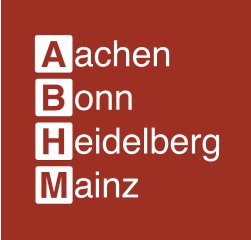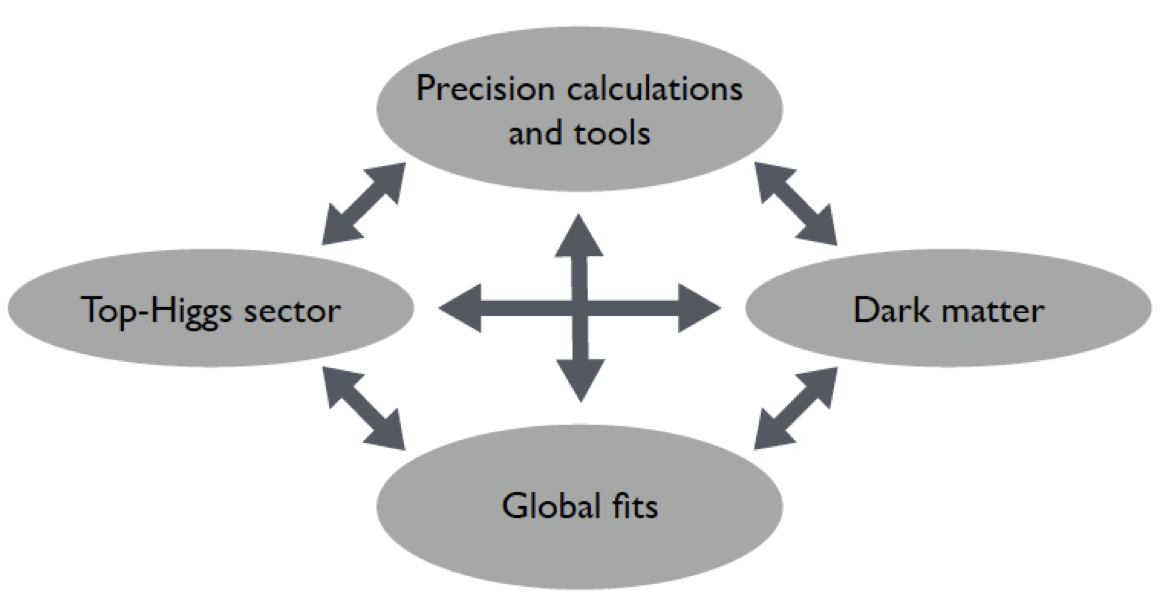You are here: Foswiki>Kraemer Web>NewPhysicsattheLHC (31 Oct 2016, MichaelKraemer)Edit Attach
 DFG Research Unit 2239: New Physics at the LHC
DFG Research Unit 2239: New Physics at the LHC Research Program
The goal of the Research Unit “New Physics at the LHC” is to provide theoretical calculations and numerical tools for TeV -scale new physics searches and exploration at the LHC, motivated by the hierarchy problem, the search for the origin of dark matter, or both. We pursue precision calculations and the developments of tools, explore the top-Higgs sector and models of dark matter, and test new physics scenarios through global fits. Specifically, we 
- A develop automated tools for calculating the production and decay of new particles at the LHC, including next-to-leading order QCD corrections and the resummation of large logarithmic corrections;
- B explore the top-Higgs sector in strongly or weakly interacting theories and in multiscale models, and analyze their LHC phenomenology in QCD signatures and through simplified models;
- C probe the nature of dark matter at the LHC in a model-independent way based on simplified models with tree- and loop-level couplings, taking into account the most important QCD effects, and study the interplay of LHC searches and other probes of dark matter;
- D develop theoretical methods and tools to improve global fits of Higgs properties and more generic new physics models, like those performed within the SFITTER and FITTINO collaborations.

Members
RWTH Aachen University
- Anke Biekötter (anke.biekoetter@rwth-aachen.de)
- Marco Hufnagel marco.hufnagel@rwth-aachen.de
- Tim Keller (tim.keller@rwth-aachen.de)
- Michael Korsmeier (korsmeier@physik.rwth-aachen.de)
- Michael Krämer (PI, mkraemer@physik.rwth-aachen.de)
- Eric Madge (eric.madge@rwth-aachen.de)
- Alexander Mück (mueck@physik.rwth-aachen.de)
- Lennart Oymanns (oymanns@physik.rwth-aachen.de)
- Frederic Poncza (poncza@physik.rwth-aachen.de)
- Jan Schütte-Engel (jan.schuette-engel@rwth-aachen.de)
- Jamie Tattersall (PI, tattersall@physik.rwth-aachen.de)
- Torsten Weber (Torsten.Weber@rwth-aachen.de)
University of Bonn
- Masaki Asano (masano@th.physik.uni-bonn.de)
- Swasti Belwal (swasti@th.physik.uni-bonn.de)
- Stefano Colucci (colucci@th.physik.uni-bonn.de)
- Manuel Drees (drees@th.physik.uni-bonn.de)
- Herbert Dreiner (PI, dreiner@uni-bonn.de)
- Bardija Najjari Farizhendi (bardia@th.physik.uni-bonn.de)
- Raghu Garani (garani@th.physik.uni-bonn.de)
- Fazlollah Hajkarim (hajkarim@th.physik.uni-bonn.de)
- Rolf Kappl (kappl@th.physik.uni-bonn.de)
- Manuel Krauß (mkrauss@th.physik.uni-bonn.de)
- Kilian Nickel (nickel@th.physik.uni-bonn.de)
- Annika Reinert (areinert@th.physik.uni-bonn.de)
- Ernany Rossi (Schmitz ernany@th.physik.uni-bonn.de)
- Toby Opferkuch (toby@th.physik.uni-bonn.de)
- Daniel Schmeier (daschm@th.physik.uni-bonn.de)
- Martin Winkler (winkler@th.physik.uni-bonn.de)
- Zhongyi Zhang (zhongyi@th.physik.uni-bonn.de)
Heidelberg University
- Martin Bauer (counterterm@gmail.com)
- Johann Brehmer (brehmer@thphys.uni-heidelberg.de
- Anja Butter (butter@thphys.uni-heidelberg.de)
- Nishita Desai (n.desai@thphys.uni-heidelberg.de)
- Juan Gonzalez-Fraile (jgzfraile@gmail.com)
- Tilman Plehn (PI, plehn@uni-heidelberg.de)
- Torben Schell (schell@thphys.uni-heidelberg.de
- Susanne Westhoff (PI, westhoff@thphys.uni-heidelberg.de)
Johannes Gutenberg University Mainz
- Michael Baker (micbaker@uni-mainz.de)
- Vedran Brdar (vbrdar@uni-mainz.de)
- Malte Buschmann (buschmann@uni-mainz.de)
- Joachim Kopp (PI, jkopp@uni-mainz.de)
- Jia Liu (liuj@uni-mainz.de)
- Lisa Michaels (lisa.michaels@uni-mainz.de)
- Xiaoping Wang (xiaowang@uni-mainz.de)
Events
Publications
- Constraints on Majorana Dark Matter from the LHC and IceCube (Jan Heisig, Michael Krämer, Mathieu Pellen, Christopher Wiebusch)
- Higher-order QCD predictions for dark matter production at the LHC in simplified models with s-channel mediators (Mihailo Backović, Michael Krämer, Fabio Maltoni, Antony Martini, Kentarou Mawatari, Mathieu Pellen) *...
Edit | Attach | Print version | History: r18 < r17 < r16 < r15 | Backlinks | View wiki text | Edit wiki text | More topic actions
Topic revision: r18 - 31 Oct 2016, MichaelKraemer
 Copyright © by the contributing authors. All material on this collaboration platform is the property of the contributing authors.
Copyright © by the contributing authors. All material on this collaboration platform is the property of the contributing authors. Ideas, requests, problems regarding Foswiki? Send feedback
